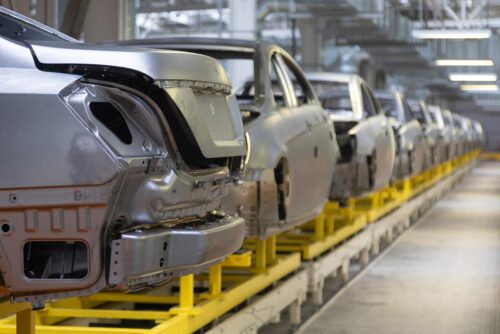
Steel Emissions Transparency in the Automotive Industry
Q&A with Jaguar Land Rover’s (JLR) Sustainable Industrial Operations Director
RMI recently developed Emissions Reporting Guidance for steel and aluminum industry stakeholders to better account for their total supply chain emissions and identify opportune areas to reduce emissions. During the pilot testing of RMI’s Steel Emissions Reporting Guidance, RMI engaged in discussions on overall decarbonization efforts with various participants.
One of our pilot partners, (JLR), spoke with us about how the company is working to reduce its Scope 3 emissions. Reuben Chorley is the Sustainable Operations Director at JLR, where he helps the Industrial Operations team (comprising manufacturing, procurement, and supply chain teams) implement business changes that go toward meeting sustainability commitments. Chorley focuses on a number of areas, including Scopes 1&2 CO2e, Scope 3 CO2e purchased goods and services (upstream), increasing circularity in supply chain, and helping ensure JLR have supplier Environmental, Social and Governance (ESG) compliance.
Chorley’s mission is part of JLR’s goal of reducing greenhouse gas emissions across operations by 46 percent by 2030. This is in addition to cutting average vehicle emissions across its value chains by 54 percent, including a 60 percent reduction throughout the use phase of JLR’s luxury vehicles. JLR’s 2030 commitments have been approved by the Science Based Targets initiative (SBTi), confirming its pathway to 1.5◦C emissions reduction in line with the Paris Agreement. JLR aims to achieve net-zero carbon emissions across its supply chain, products, and operations by 2039.
(Please note that this information does not constitute an endorsement of any specific decarbonization strategy or company).
1. What are the approaches you’ve taken to achieve your supply chain goals?
JLR has set very clear goals through our Reimagine strategy, which places sustainability at the heart of everything we do.
We have taken the decision to embed CO2e reduction metrics into our Enterprise level scorecard. This really helps to reinforce the fact that it is everyone’s responsibility within JLR to deliver on this commitment.
But to meet our commitments we also need our suppliers to reduce their CO2e impact, so we have recently launched a new system that gives our procurement teams a target CO2e value when we are sourcing new products. This combined with annualized targets to reduce CO2e per car is changing how every buyer engages with our supply base.
In addition to this, we are collaborating with our supplier partners, engineering, and design, to understand how to embed circularity into everything we do. Our aim is to do more with less, to increase our re-use and the recycled content of the components we are purchasing, as well as develop closed loops so that when our vehicles reach their end of life the materials within them can be fed back into our supply chain.
And finally, when I consider our products, we will launch nine pure electric luxury vehicles by 2030. Jaguar will be reimagined as an all-electric luxury brand from 2025 and Range Rover, Defender and Discovery will all welcome pure electric variants, with the first being the all-electric Range Rover launching in 2024.
2. What are the main metrics you’re using to ensure that you’re on track to achieve your supply chain goals?
We require recycled content, renewable energy utilization, and details on carbon footprint from our suppliers of components and materials. We also take a holistic view of social and governance matters for all our supplied goods and services, as sustainability is not just about CO2e reduction; it is about doing the right thing in the right way.
3. Did you face any challenges in collecting metrics and how do you expect RMI’s Steel GHG Emissions Reporting Guidance and accompanying data exchange formats to help you?
The high number of components and materials on a vehicle point to the usual big data challenges of volume, variety, and velocity. It is therefore pertinent for emissions data from suppliers to be received in an easy to ingest and exchange format that’s compatible with our existing data platforms. We currently receive supplier emissions data; however, it is proving to be a challenging process as we must independently verify inconsistent methodologies used in evaluating sustainability and circularity metrics.
We expect RMI’s guidance to remove some of the supplier’s data hurdles, such as inconsistent methodological approaches to metrics evaluation and data format inconsistency. The standardized approach would reduce administrative burden by making it easy to integrate supplier’s data into our sustainability evaluation, allowing for consistent target setting and enabling us to identify supply chain hot spot areas to focus our decarbonization efforts.
The RMI methodology, should it gain wider industry acceptance, could potentially deliver a harmonised and consistent approach to measuring sustainability metrics which could then facilitate easier benchmarking of competing products and suppliers. The integration with Enterprise resource planning (ERP) systems such as SAP, could make it easier to gather supplier data enabling scaling up of supply chain decarbonization ambitions.
4. How have you seen pressures and incentives for producing/sourcing low-carbon goods change over time at your company?
JLR endeavours to go beyond just meeting legislative requirements. However, compliance with regulations positively influences good practices, and in some cases, facilitates harmonization of sustainability measurements across the automotive industry. For example, the European Union battery regulations on mandatory carbon footprint enables a consistent methodology for evaluating the carbon footprint of electric vehicle batteries, which makes comparing different suppliers much easier.
RMI is always looking for new collaborators to drive the energy transition. If you or your company is interested in connecting with our team, please contact Linda Jirouskova (ljirouskova@rmi.org).


